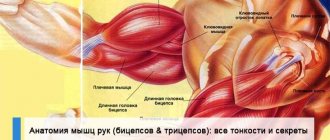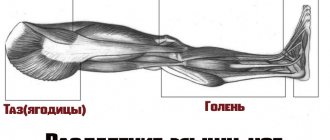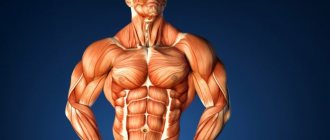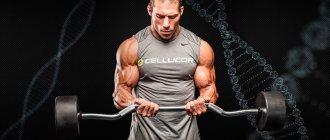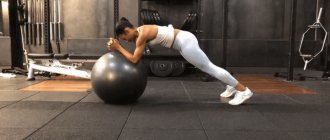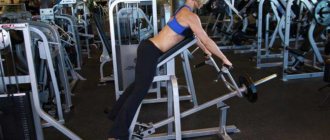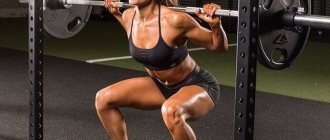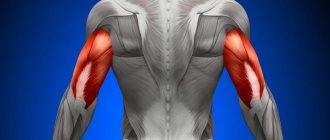It is necessary to warm up and cool down before and after training for any muscle groups, including when pumping up the abs and back. Before a core strengthening session, you need to speed up blood flow, speed up metabolic processes and adjust the nervous system to prepare the body for the load. After training, a short cool-down is performed to slow down all running mechanisms.
We offer you a ready-made warm-up and stretching program for the abs, core and back, which is suitable not only for performing before or after training, but also as a morning exercise for a healthy spine.
Abdominal stretch with emphasis on the forearms
What muscles are we stretching: rectus abdominis muscle.
Performance. Lie on your stomach and lift your chest, resting on your elbows. As you perform this exercise, you should feel a slight stretch in your abdominal area.
A comment. The rectus abdominis usually doesn't require much stretching, so doing this exercise a few times a week after your ab workout will do the trick.
What is cyclic aerobics? Advantages and disadvantages
This category of exercises includes running, walking, swimming, cycling, and skiing. To train the cardiovascular and bronchopulmonary systems, 20–30 minutes of brisk walking three to four times a week is enough.
In cyclic aerobics, the whole body works simultaneously and the breathing is active.
Each type has its own characteristics.
Run
These are thousands of blows to the joints of the legs and spine, even for technically trained athletes. This means that arthrosis and osteochondrosis of the spine are possible in the future.
At the same time, you cannot have a single extra kilogram. It is better to run in special sports shoes for running. I don’t think it’s right to become interested in city running on asphalt, especially marathons.
Asphalt is an aggressive environment for joints. But if you happen to run on asphalt, then the next day after such a run you need to get your joints in order. And only special simulators or rubber shock absorbers put things in order, activating the deep own ligaments and muscles of the joints in decompression mode.
I’m not even talking about a cold bath or shower - this is the first procedure after running! It is preferable to run on dirt - in a park or on rough terrain.
Bicycle aerobics
With such a load, only the legs work. The arms, and therefore the upper body, are passive.
In addition, riding a bicycle around the city means that your lungs consume a lot of exhaust gases. Cross-country cycling is already cross-country, and is more suitable for young people.
Swimming
I often tell my patients who ask about the benefits of swimming: “I spent half my life in the pool and ... I do not recommend swimming as an aerobic exercise for one simple reason. People who come to the pool for this task do not know how to swim in an aerobic mode, that is, quickly, long and technically. They swim, creating only the illusion of swimming.” I tell men that they need to swim 1500 meters without stopping in a maximum of 30 minutes, only then is it good. Moreover, breaststroke, butterfly, and backstroke are suitable only for competitive swimmers. These are very complex and difficult techniques. What remains is the rabbit. Women can swim this distance five minutes longer. If it works out, then twice a week is enough. And here the problem of excess weight is relevant. Whoever has it easier will benefit more!
Mountain tourism
The most difficult load is mountain tourism. Neither weight, nor age, nor even shoes (although it is better to choose special walking shoes) prevent you from taking first short, then longer walks. Increasing the load involves covering an increasingly longer distance in the same amount of time.
Be sure to monitor your heart rate before, immediately, and 5 minutes after finishing your workout.
Skis
Smooth skiing is perhaps the most beneficial aerobic exercise in winter. It's great if there is such an opportunity. The conditions are the same as when walking, only the duration of the exercise is 45–60 minutes or more.
Standing abdominal stretch
What muscles are we stretching: rectus abdominis muscle.
Performance. Stand with your back to any support, feet resting on the floor at the base. Raise your arms above your head, grasp the support and, without lifting your feet from the floor, bend forward slightly.
A comment. This exercise carefully and efficiently stretches not only the abdominal muscle group, but also other equally important ones: the latissimus dorsi and triceps. While stretching, remember to keep your body relaxed.
Safety rules for stretching
Any exercise that stretches your back muscles should be done with caution. It is very important to train regularly and not overexert yourself right away - the load should increase gradually. When performing exercises, the spine should not crunch. If this happens, it is better to refuse independent exercises at home and perform sets of therapeutic and preventive exercises in the future only under the supervision of a doctor.
It is necessary to avoid any sudden movements or doing anything through pain. Also, you should not perform exercises during the period of exacerbation of any diseases of the musculoskeletal system. If the disease is in an acute phase, then training can only aggravate the patient’s condition. Wait for recovery.
It is better to train in the evening every day. The amplitude of movements at the initial stage may be minimal. When performing any exercise, it is necessary to relax the back muscles as much as possible, this way they will be stretched much faster.
Sincerely, Arina Klishina
Side stretch while lying down
What muscles are we stretching: obliques, latissimus dorsi, quadratus lumbar muscles.
Performance. Lie on your back with one side pressed against a wall or any other support, and stretch your arms behind your head. Then begin to pull your upper body in the opposite direction. At the same time, the legs and hips should not come off the wall.
A comment. Placing your hands behind your head engages the latissimus dorsi and teres major muscles. They pull the arm back and down, bringing it towards the body (adduction), and also rotate it inward (pronation). If your arms remain extended along your body, only your abdominal muscles will be stretched.
Squats. Developing the lower limb girdle
Squats are performed accompanied by a diaphragmatic exhalation “haaa”, that is, an active exhalation with each extension of the legs (when standing up).
This is not a burden on the heart, but a help to it. That is, the “peripheral heart” picks up the arterial wave of blood and delivers it back to the heart while maintaining the required speed and volume of blood flow.
Nature has not come up with other mechanisms for maintaining normal blood flow. Therefore, weak legs mean a weak heart!
Squats are one of the main exercises that help the heart, and in case of heart disease (coronary artery disease, arrhythmia), physical activity “corrupts” the body, simultaneously promoting muscle atrophy.
There are two techniques for squats: without support (arms up) and with a fixed support.
Contraindications:
- coxarthrosis of the hip joints (dysplastic or deforming),
- deforming gonarthrosis of III–IV degree (damage to the knee joints).
It must be taken into account that today many incorrect diagnoses are made when doctors do not even check the functions of the joint. Therefore, before starting a lesson, you should carry out a correct diagnosis.
Squat technique: how to do squats correctly?
To do squats with a straight back, hold on to rubber shock absorbers attached to a stationary support or a wall bars.
This allows you to turn off your back muscles and turn on only your leg muscles. I also advise you to squat in the sea, standing deep in the water (hands on the water), as well as in the pool at the side, holding the handrails. Squats in water can be done by people even with not entirely healthy hip joints: gravity is reduced and the body weight does not “put pressure” on the articular surfaces.
Try squatting 10 times first. Bend your knees to the angle that your joints and muscles allow. Usually, to begin with, you should not lower your thigh below your knee.
It happens that the leg muscles are so weakened that a person literally sinks to the floor in a squat and cannot get up. In this case, it is enough that the angle between the thigh and lower leg is 90 ° (thigh parallel to the floor).
If the next day there is no muscle pain, you can increase the series of squats to two or three, that is, increase the total number of repetitions to 20–30.
I don’t recommend doing more than three series of 10 squats in the first days. This applies to people who are physically weak.
It is necessary to focus on your condition that arises after the first days of training, primarily on muscle pain and heart rate. In addition, in the first days, blood pressure and even body temperature may increase. These are normal adaptive reactions.
The body must be trained gradually and patiently. Take your time to increase your exercise numbers. Treat yourself and your condition soberly and adequately. No need for fanaticism.
Squats can be performed daily in small series of 30 to 50 - three times 10 squats, five times 10 squats, etc., or every other day - from 50 to 150.
Squats are simply necessary for those who sit a lot (office workers, accountants, drivers, etc.).
Squats can replace running, cycling, swimming, walking.
One of the physical indicators of sufficient load when squats in healthy (young) people is a burning sensation in the muscles of the anterior thigh (quadriceps femoris). But this sign is for the prepared, and can occur at the end of each series of exercises. In this case, it is possible to overcome the “burning” in the muscles until they “failure” - for those who are very prepared, that is, to the point where it is impossible to continue this exercise. The interval between series is 10–20 seconds, but no more.
After squats, I recommend stretching the muscles of your legs and back. Any stretching after performing strength exercises is necessary so that the muscles do not hurt the next day.
If you decide to end the session with just squats, be sure to soak your feet in cold water for 5-10 seconds after finishing, or completely immerse yourself in a cold water bath.
Then you need to rub your feet dry with a hard towel. Don't forget to rub the oil (cream) into your feet (so the skin doesn't dry out). After exercise, the cosmetic effect of the cream rubbed into the skin is much higher.
Side stretch in pairs
What muscles are we stretching: obliques, latissimus dorsi, quadratus lumbar muscles.
Performance. Stand with your partner side to side at a distance of about one step, feet together. Grasp each other's forearms on the inside, raise your hands on the outside and clasp your palms together, forming an arch. From this position, gently bend away from your partner, stretching the outer side of your body. The legs should not leave the floor or change position.
A comment. It is advisable that you do not differ much from each other in height and weight, otherwise the exercise will not be very convenient and effective. The main goal is to stretch the entire side, including the glutes, obliques, and latissimus dorsi.
General rules for performing stretch fitness
- The body must be stretched only to a certain limit; the appearance of pain must be perceived as reaching the maximum in overstretching of the muscle fibers. There should not be any severe pain;
- Before stretch exercises, you should do a comprehensive warm-up for the whole body, this ensures a rush of blood to the muscles and increases elasticity;
- You need to monitor your breathing, it should be smooth, rhythmic, there is no need to emphasize inhalation and exhalation. Exhale when bending, inhale air while stretching. It is recommended to breathe deeply while changing positions;
- Each pose taken is held for 10-30 seconds;
- During exercise, you must maintain a stable position.
After stretching, the muscle fibers should be in a relaxed state, so strength training should not be performed.
"Cat"
What muscles are we stretching: the rectus abdominis muscle, a group of straightening muscles of the back.
Performance. Get on all fours, focusing on straight arms and knees. Pull your stomach in so that your back arches upward. In this position, relax and press your torso down, creating a reverse arch in your spine. Then take a deep breath, stretch your stomach and, as you exhale slowly, tighten your abdominal muscles.
A comment. This exercise has a positive effect on the mobility of the spine and the small muscles surrounding it. It is also worth paying attention to the importance of stretching the spinal column, especially in the lumbar region.
What to do after stretching
After each exercise you need to smoothly return to normal. Then you can safely go change clothes.
Horizontal bar! Hang on it as long as you can. This is a great addition to the whole package you've made. Plus unloading of the spine.
Remember - no matter what stretch you initially have, you can make it bigger. We don't promise that you will do the splits, but you will definitely become more flexible. And flexibility is the health of muscles and joints, grace and beauty.
"Boat"
What muscles are we stretching: gluteus medius and maximus, iliocostal muscles.
Performance. Lie on your back, bend your knees and pull them as high as possible (almost to your chin), clasping them with your arms. The spine should form a slight arch, and there should be no feeling of discomfort in the cervical region. Relax and stay in this position.
A comment. This exercise makes your spine and surrounding muscles more mobile and removes tension. Especially useful for the lumbar region.
"Rear" of the body. How to strengthen your back muscles
If the abdominal muscles are the front of the body (front), then the back muscles are its rear.
A home version of exercises for the lower back muscles is the “half bridge.” This exercise strengthens the lower back.
IP: lying on your back, legs bent at the knees or lying on a bench (chair, bed).
There are two possible ways to perform the exercise.
The first is that your feet rest against the edge of the bench - this is a difficult option.
The second - the lower leg lies completely on the bench - for the weakened.
The goal of the exercise is to raise the pelvis as high as possible by contracting the gluteal muscles. It is advisable to linger for two to three seconds at the top point in order to feel the tense muscles.
Main indications:
- osteochondrosis of the lumbar and thoracic spine,
- constipation,
- rectal fissures,
- irritable bowel syndrome.
Even very weakened practitioners can perform the exercise.
Do not abuse the number of repetitions - 10–20, no more. You can do two or three episodes.
“Half-bridge” can and is even recommended to alternate with exercises for the abdominal muscles. This way you don’t get bored, and the effect of the exercise increases. But in this case, perform both exercises with the same number of repetitions: 10, 15 or 20, so as not to get confused.
Spinal twists with the help of a partner
What muscles are we stretching: oblique abdominal muscles.
Performance. Sit on a flat bench, back straight, bodybar (or bar) resting on your shoulders, you hold on to it at both ends (arms as wide as possible). Your partner stands behind you, grabs the bodybar in the same places where your hands are, and gently turns you to the side until you feel a stretch in the oblique abdominal muscles. Then return to the starting position, inhale and exhale and repeat the twist, but in the other direction.
A comment. Due to the tension in the rotator cuff muscles, this exercise cannot be performed correctly without assistance. To get the greatest effect, you should relax your abdominal muscles and exhale as you twist to the side.
To do this stretch on your own, place your hands behind your head and twist yourself from side to side. This can be done even while sitting at your desk.
Why and when to stretch muscles?
Stretching exercises are the final element in your training. It is best to do it at the end, when you are as warmed up as possible. Some people also stretch at the beginning of their workout. This can be done as a completion of the warm-up, but the decisive procedure is best left for later.
Remember that stretching makes your muscles flexible and elastic.
Why is plasticity needed?
- Firstly, a flexible body means more possibilities. It will be easier for you to perform strength exercises, there will be fewer injuries during falls or accidental unnatural movements. Your muscles will be able to stretch and not be injured as a result.
- Secondly – health! Stretching exercises are an excellent aid to the joint apparatus and prevent its immobilization.
If you have chosen a strength sport (working on strength), then stretching will stimulate the growth of new muscle fibers, and subsequently strength.
Side stretch on the floor
What muscles are we stretching: obliques, latissimus dorsi, quadratus lumbar muscles.
Performance. Sitting on your heels, move one leg to the side. In this position, begin to stretch your arm up and to the side until you feel a stretch in the side muscles. The second hand rests on the floor.
A comment. During this stretch, you should feel a stretch throughout the side of your body. If you don't feel anything, try moving your leg further to the side and extending your arm further, thereby increasing the resulting arc.
Push-ups are the hardest exercise
This is already the third floor of the body.
You can perform push-ups in different positions:
- classic from the floor (with different positions of the hands),
- from my knees,
- from the wall.
Advice, proven by practice: each exercise should be done not with thoughts about the difficulty and complexity of its implementation (otherwise you will quickly get tired), but imagine the muscles that are working.
For example, when doing a push-up, imagine yourself with the muscles of your back (spine) and the muscles of your arms performing the movement. Then you will be able to feel and “see” your straight back (from the pelvis to the neck), the flexion and extension of power mechanisms called the muscles of the upper limbs, etc. When the brain is “disconnected” from the exercise that needs to be performed (and the brain is also feelings, emotions, fear, fatigue, self-doubt), and the exercises are performed by individual muscles (not you - the body!), then you will not feel tired. You just need to program yourself for a certain number of movements. For example, I can “turn” myself into a machine for push-ups or squats and look at this machine as if from the outside, monitoring the correctness of these exercises. It's not me doing push-ups, it's the machine!
You will learn this a little later, but for now start small - 5-10 push-ups, squats, abdominal exercises, gradually increasing the series.
Stretching and pregnancy
Stretching is not prohibited for pregnant girls if several conditions are met:
- The expectant mother’s well-being does not suffer, there are no complications or risks;
- All movements are carried out smoothly and carefully;
- A set of classes is conducted under the supervision of a professional instructor;
- Bends from a standing position are excluded from training. Pregnant women should bend over when stretching muscles only in a sitting position.
Stretching for pregnant women is an ideal option for preparing the body for bearing a baby and for childbirth. Regular exercise improves muscle elasticity, allows you to maintain body weight within normal limits, normalizes mood, and prevents muscle cramps.
Stretching is contraindicated for pregnant women if:
- Threat of premature birth or early miscarriage;
- Placenta previa;
- Hypertension;
- Weakness of the cervix.
You should temporarily stop exercising if you experience nagging pain in the lower abdomen and spotting.
